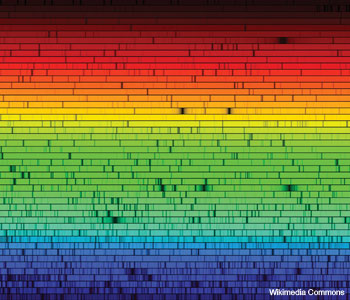Feature
A Brief History of Spectral Analysis and Astrospectroscopy
From Newton’s first insight into the composition of sunlight to the discovery of helium on the sun two centuries later, scientists’ work on the measurement and analysis of light has led to important discoveries that have greatly expanded our knowledge of physics, chemistry and astronomy.
 Dark Fraunhofer absorption lines superposed on the sun's background continuous spectrum.
Dark Fraunhofer absorption lines superposed on the sun's background continuous spectrum.
Spectral analysis is important in many branches of chemistry, physics and the life sciences. Its foundation lies in the phenomenon that different forms of matter produce characteristic absorption and emission spectra that can be used to identify their atomic and molecular structure. The history of modern physics—and particularly the development of quantum mechanics—was motivated by studies of the wavelength dependence of black body radiation and the precise spectroscopic measurements of atoms and molecules, including their light absorption and emission wavelengths, polarization, selection rules and intensities.
…Log in or become a member to view the full text of this article.
This article may be available for purchase via the search at Optica Publishing Group.
Optica Members get the full text of Optics & Photonics News, plus a variety of other member benefits.
